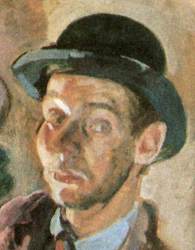

In 1931 he won the painter's scholarship of the Capital City of Budapest and with that money he travelled to Paris. He managed to go to Italy by dint of the Korb Erzsébet Scholarship in 1934 for the first time. In 1936 and 1937 he spent a year in Italy at the Rome-based Collegium Hungaricum thanks to a Hungarian scholarship. In the meantime he also spent some time and worked in Nagybánya (Baia-Mare, Romania). After the Vienna Verdict he took up his residence in Nagybánya again. In 1924 he won one of the prizes of the exhibition of the Nagybánya Saint Stephen Festival Week. From 1944 he worked in Szentendre.
From 1923 he appeared regularly at exhibitions. In 1978 he was awarded the Munkácsy Prize. His main theme is the everyday life and work of the people of the land, the peasantry. His expressive realism renders his still-lifes and landscapes exuberant, whereas his self-portraits are repositories of the traditions of major art periods. One of his most outstanding painting accomplishments is a gigantic mural painted with the application of the secco-method. The mural decorates the side wall of the sanctuary of the Roman Catholic church in Érmihályfalva (Valea Iui Mihai, Romania). He also dealt with etching.
An exhibition presenting his oeuvre was opened in Szentendre in 1983. In 2003 a centennial exhibition dedicated to his memory was organised in Budapest.